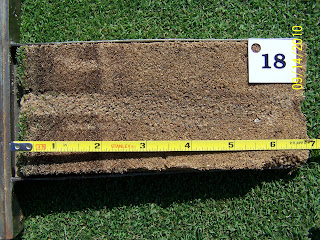In the following photos you will see some profiles that contain both DryJect and core aeration results in the same profile. I have also included a few that show individual results.
 |
| In this photo you can see the large DryJect shot on top and below that, a 2 week old core aeration hole. The core hole looks like a carrot, barely reaching two inches. Also note that in the core hole, the sand has settled leaving a gap. The DryJect shot is filled to the surface providing for smooth ball roll immediately following brushing. |
 |
| Here you can see the excellent DryJect shot exceeding 4 inches. Below that is a core hole several years old, now buried under topdressing. However, you can see the same short "carrot" shape as the previous photo. |
 |
| This photo is of a two week old core aeration hole. Note the familiar carrot shape and not reaching even two inches in depth. |
 |
| This profile is from the same green as the previous profile. Note the healthy DryJect shot to 4 1/2 inches. |
 |
| This photo shows a two week old core hole, sand settled leaving a nasty bump on the surface |
 |
| This profile is from a green which I personally core aerated last fall. Note the limited area of soil affected and also depth not exceeding two inches. |
 |
| Another profile on the same green, short carrot core hole |
 |
| Again, the same green as the last two profiles with the carrot shape hole. This is a backyard homeowner green, poorly constructed as you can see by the variability in the rootzone. |
 |
| A great DryJect shot 6 inches into the profile. Injection rate at this green exceeded 500 pounds of sand per 1000 sq ft. |
|
My conclusions from the past two seasons of observing the DryJect process:
1. There is no comparison between how superior the DryJect process is to that of core aeration in terms of depth and amount of sand put into the profile.
2. There is no comparison of the superior playability of a DryJect treated green versus core aeration.
3. I have yet to see a core aeration hole greater than 2 inches in depth.
4. Core aeration holes are very limited in the area of the profile affected. DryJect with the "Lightning Strike" blasts reach areas that coring cannot.
I will continue to search for such comparisons in greens. Coupled with the great penetration and efficiency of sand use, it appears that DryJect is a winner.






























